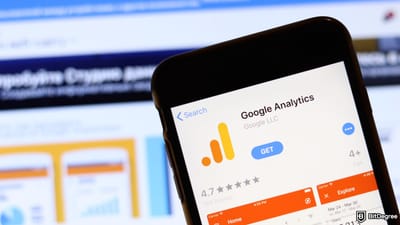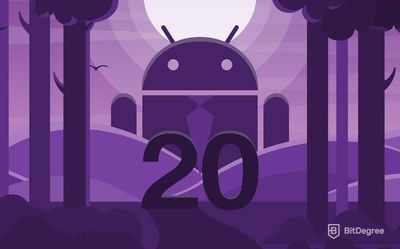Stop overpaying - start transferring money with Ogvio. Join the waitlist & grab early Rewards NOW! 🎁
Distance learning has been all the rage since the start of the COVID-19 pandemic. As the world shut down, schools moved to the digital space. Universities have spent months making their courses available online. Some students have even received their diplomas without attending a single in-person class!
Digital school, remote studies, hybrid learning. Now that education has been remote for quite some time, you might’ve heard some of these terms. They define the most innovative learning strategies in the digital age. Technology has been a real game-changer to the education sector.
But what is distance learning exactly? How does it work? What are some of the distance learning benefits?
In this article, I’m going to introduce you to this concept and show you how it works during a pandemic. I’ll also share some distance learning tips and tricks, and give some pointers on how to choose the best distance learning courses.
So, let's get started.
Table of Contents
- 1. What Is Distance Learning?
- 1.1. Synchronous Learning
- 1.2. Asynchronous Learning
- 2. Remote Learning During the COVID-19 Pandemic
- 3. What Makes Distance Learning Worth It?
- 4. The Downsides of Distance Learning
- 5. The Dos and Don'ts of Learning from Home
- 6. Prospects and Opportunities with Distance Learning
- 7. Choosing the Right Online Course
- 8. Conclusions
What Is Distance Learning?
You might be wondering, what is distance learning? Is it any different from remote learning? Nope! They’re both names for a learning method where teachers and students hold classes online instead of in a classroom. Students can even be scattered across the world and still attend the same class at the same time.
Latest DataCamp Coupon Found:Distance learning and digital learning are not exactly the same thing, but they overlap. Learning remotely doesn’t necessarily require digital technologies. You can call a teacher with your landline phone if you want (and still have one). However, remote learning can be and often is digital.

There are two types of approaches to distance education – synchronous and asynchronous learning. Synchronous learning is very similar to studying in a classroom. The teacher and the students are all online at the same time, communicating live – hence “synchronous” learning.
On the other hand, asynchronous learning doesn’t require you to be online at the same time. Asynchronous distance learning may involve watching a video recording of a lecture, listening to a podcast, or even reading this article we wrote about how to become a teacher.

You might've also heard of hybrid learning. It’s a combination of in-person and distance learning. Some parts of a course might be taught in a classroom. Others can be accessed online. Essentially, it’s a mish-mash of physical, synchronous, and asynchronous learning. It’s gaining popularity as classrooms slowly reopen.
Synchronous Learning
Synchronous learning is exactly what the name suggests. It’s a way of learning online together with your classmates and teacher on a live call. Students and teachers can talk like they would in a real classroom. While it can just be a phone call, it’s more common to use digital software for synchronous distance education.

Synchronous learning tools have been gaining popularity since spring 2020. This is all thanks to classrooms suddenly moving to the digital space. Some of the most popular are video conferencing tools for digital learning.
It's not just a local phenomenon either. From the start of the COVID-19 pandemic, more than half the learners in Europe have been using video conferencing tools[1].
Tools used for synchronous learning aren’t limited to just that. In the last couple of years, you’ve probably had to use software like Zoom or Microsoft Teams for work or leisure (and realized that you forgot to turn your microphone on, again). It’s become one of the most popular communication tools worldwide.
Asynchronous Learning
Defining asynchronous learning is a little trickier than synchronous. It’s a type of distance learning that happens neither in the same place nor at the same time. The teacher doesn’t even have to be online. Essentially, it’s a type of self-study. This can take many forms – a video recording, a slide show or a book, to name a few.
One type of asynchronous learning that has exploded over the pandemic is MOOCs. MOOCs, or massive online open courses, are, as the name suggests, courses available online for all learners. Often these online courses are curated by top-ranking universities and taught by experts in their fields.
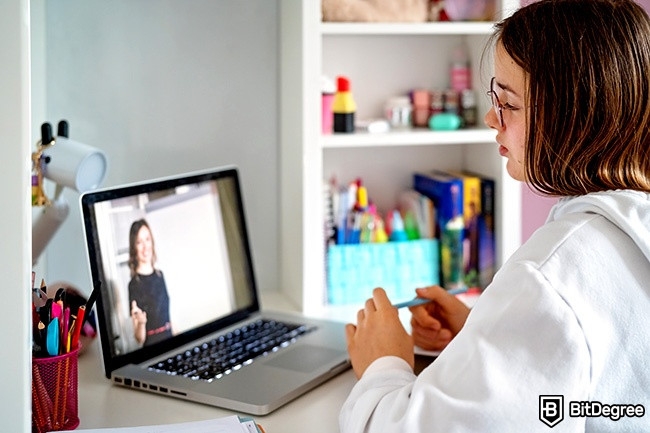
There is a wide array of MOOC platforms to choose from. You might’ve even heard of platforms like Udemy, Udacity or DataCamp. Many of them provide their classes free of charge or offer a short trial period to try it out without paying. And once you finish a course, you can receive a certificate of completion.
Asynchronous learning platforms have been flourishing lately. According to recent studies, free distance learning courses have become increasingly popular among pupils in Europe. Forbes reports that the value of the online learning platform Coursera has nearly tripled from $2.6 billion in July 2020 to $7 billion in April 2021.
Both asynchronous and synchronous learning tools are now some of the fastest-growing software markets in the world. All this is thanks to the worldwide lockdowns and the overnight shift to distance education.
Remote Learning During the COVID-19 Pandemic
There’s been tons of research done on learning remotely during the pandemic. A lot of it has to do with distance learning benefits and online tools. One European study has revealed that most pupils already have at least the most basic digital skills[1].
It's also shown a massive increase in the usage of video conferencing tools – up to 94% in some countries.

It’s been proven that children’s digital skills have improved during the lockdowns. Not only have they worked on their old skills, but thanks to distance learning courses, they had a chance to try out new technologies. This doesn’t just apply to digital abilities, either.
Based on interviews with school children, they have learned to be better at studying on their own. Despite the stress of the sudden shift from in-person to distance learning, there appear to be many benefits to the new methods.
Research also shows that parents are just as interested in digital learning benefits as their children. Many parents say that their kids have become better at using digital technologies.
They also engage with the distance learning materials together with their children. Some have even opted to enroll their kids in MOOCs to help further develop their skills.
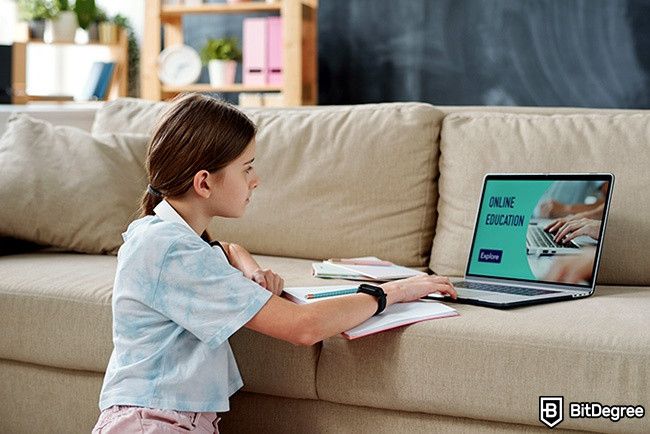
Some of the most popular MOOCs among child learners are programming and robotics courses. The IT sector is flourishing, so no wonder parents want to invest in their children’s future.
From app development to programmable toys – the opportunities are endless for all ages. You can read our article that delves deeper into the best approaches to raising the next big developer here.
The COVID-19 pandemic has reshaped the demand for knowledge itself. Volunteers have become a crucial part of crisis management. Obviously, a volunteer can’t spend years training the way a doctor would. It needs to be done quickly and efficiently.
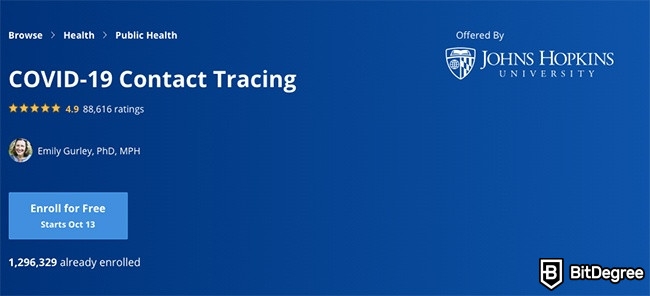
Distance learning courses can be invaluable here. Coursera offers a class on COVID-19 contact tracing. It lasts only seven hours and can be completed free of charge, so volunteers can study quickly and join the pandemic prevention efforts without any delay.
What Makes Distance Learning Worth It?
We’ve had plenty of time by now to compare in-class learning with distance learning. Even now, schools and universities keep switching between studying remotely and in person, using a more hybrid approach. Both methods of studying have their own advantages and disadvantages.
But where does online education hold the upper hand?
Firstly, and most obviously, distance learning is convenient. No commuting, no traffic, no rushing down the corridors. All your classes are available anywhere, so long as you have an internet connection. You don’t even have to leave your bed!

You can’t ignore the sense of security either. It definitely feels nicer to stay safe at home and not worry about catching something in a crowded classroom. It’s easier to study when you don’t have to sneeze every five minutes. And that’s pretty relevant during a pandemic.
Along with physical convenience comes saved time. It’s always nice to have those extra five minutes of sleep in the morning. If you’re studying at home, you might find yourself with more free time. This lets you get more done, whether the “more” is housework or napping.
Also, if your distance learning is asynchronous, you can set your own schedule and work as fast or slow as you want. DataCamp offers its users an easy-to-use mobile app so you can study at your convenience even when you’re on the go.
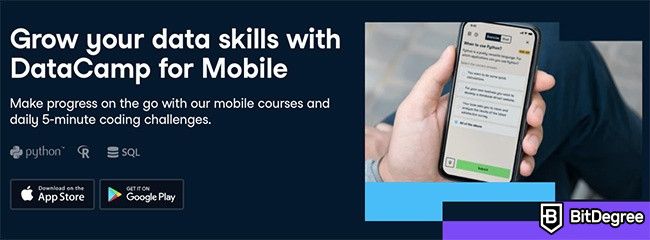
Remote studying also means you have access to technology at all times. You can easily take advantage of the resources at hand. It’s so much faster to track your notes and prepare for assignments. Struggling with software? You can find plenty of tutorials, like this helpful guide to using Excel. The digital world is at your fingertips.
Are you interested in aesthetics? Have you always found your notebooks too boring or unoriginal? Try out one of the top-rated graphic design courses offered by Skillshare and use your newly acquired skills to create something that reflects your taste. Use these skills to impress your peers or create your unique stationery.
Among everyone involved in this method, distance learning benefits students the most[2]. Whether you’re a fast learner or prefer taking things slow, digital tools can help out. Online education offers flexibility for the student. The learning process is no longer just a book and a blackboard. It can include audio, videos, and even games.

It just goes to show that convenience saves time. And all the time you save by not leaving the house can be spent enjoying your hobbies, developing new skills, or just binge-watching that TV show you said you’d get to two years ago.
And thanks to the opportunities given by the distance learning courses, it’s easier than ever to work on your knowledge and career. All this content is available online, whenever you need it. There’s never been a better time to take advantage of online tutorials and courses.
The Downsides of Distance Learning
No learning method is perfect. Different techniques work for different people. Switching to a new learning system means facing new challenges. And when your peers aren’t by your side to face them, it can get confusing. So, despite all its perks, distance learning does have some drawbacks.

One of the biggest concerns at the start of the pandemic was access to technology. In the early weeks, some people simply didn’t own enough devices needed to study remotely and were forced to purchase new, often expensive equipment. Truth be told, distance learning can be costly.
However, by now there are tons of ways to adapt. Most digital tools and services have been adapted to be mobile-friendly. The most essential tools you need are usually a screen, a microphone, and a camera. So you don’t need an entire desktop to study successfully – your phone can be enough.

The distance itself is a big issue. The pandemic has led to many people facing isolation. Some learners study better when they are surrounded by peers.
So, suddenly leaving the classrooms and learning remotely can impact their performance. It can be harder to complete group projects or hold discussions when all you’re seeing is a screen full of muted black rectangles.
Thankfully, technology itself can help here. Group chats and video calls after class can help maintain communication and build team spirit. If it’s safe, small groups can arrange meetings in person and discuss together.
It's hard enough for teachers to respond to every question and virtually raised hand in a video call. With asynchronous learning, it can seem like there’s no live feedback. It’s easy to feel stranded. But this might just take a bit of extra communication. Don’t be afraid to get in touch with the lecturer if you have any questions.
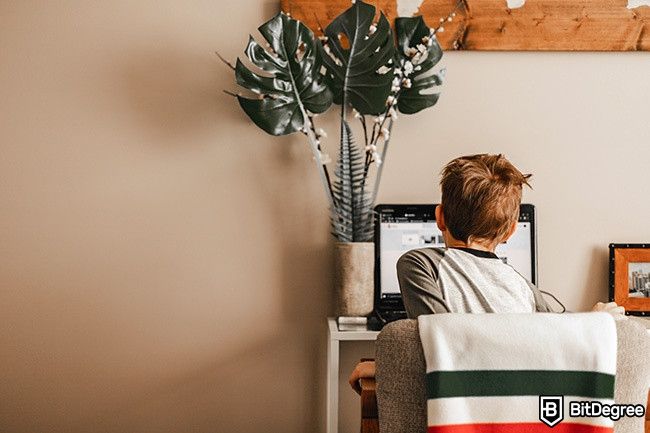
Unfortunately, not everyone has the skills required to learn online comfortably. Whether it’s a lack of technical knowledge or simply a matter of convenience, adjustment to distance education can be challenging. Not to mention situations where each class requires different tools to work.
Luckily, there are plenty of resources available to work on these skills. You can find anything from message boards to blogs about distance learning courses curated for those just dipping their toes in the digital education waters. You can even try a free class on learning how to learn with Coursera. We even have an overview for you.
The Dos and Don'ts of Learning from Home
Of course, distance learning can be hard to get used to at first. It requires a lot of concentration. Staring at the screen all day can be draining. In fact, health problems are among the top concerns for parents and pupils alike. And that Twitter tab pinned to your browser is so tempting…
Distance learning and effective learning are not the same thing. Like all skills, it requires commitment and determination to achieve the results you want. You won’t graduate with honors by just joining the video conference and muting your microphone. Digital or not, you are responsible for your learning.

So, here are some helpful distance learning tips that will help you succeed:
- Be organized.
It’s obvious, but it’s tried and true. This goes for just about anything – from your notes to the workspace. Keep separate folders for each of your subjects. Take advantage of digital planners – they can be a life-changer. Highlight your assignment and exam requirements. It’ll make your life so much easier. - Stay committed.
Getting used to distance learning takes time. Start building the right habits from day one. Don’t sleep in until the moment you need to log in. Don’t leave your assignments to the last minute. You’re still studying as usual, just in a different environment. Maintaining a routine helps you stay on top of your studies. - Take notes.
Seriously. Zoom fatigue is a real thing. And zoning out can really backfire once it’s time to study for your exams. Taking notes on your device is ridiculously easy. You can thank me later. - Help each other.
Your feedback can be invaluable to your peers. It's one of the standout features of MOOC platforms. Udemy has a great range of high-quality free courses. But with a paid plan, not only will you earn a certificate, you’ll be able to access assignments. The tasks are peer-reviewed, so you and the other students can help each other.

It's not only about what you do to learn efficiently, though. It's also about what you don't do. Here are a few things to avoid:
- Don’t multitask.
Yes, the digital era is notoriously fast-paced. But if you’re trying to do five things at once, you won’t excel at any of them. Mute those constantly buzzing notifications, set an hour or two in your schedule just for studying. Try something like the Pomodoro technique for studying sprints. Learning takes dedication. - Don’t set your hobbies aside.
Free time is a very neat perk of distance learning. Online learning platforms offer thousands of courses to add to your general education. As Bo Burnham’s song goes, “If none of it's of interest to you, you'd be the first.” Use your spare time to discover a new hobby, or explore a subject you’ve always been interested in. - Don't neglect your body.
It can be a little too easy to plug in and forget to step away from the screen. Staying active is important to your body and mind. Don’t forget to take breaks, get some exercise, rest your eyes, eat well, and drink water. - Don't forget about your mental health, either.
Burning out is a big risk with distance learning. You can’t take in any more information when your brain is fried. If you’re feeling drained, you can take a look at this course about happiness and well-being offered by Yale University (yes, that Yale University). Learning can be about improving your health, too.
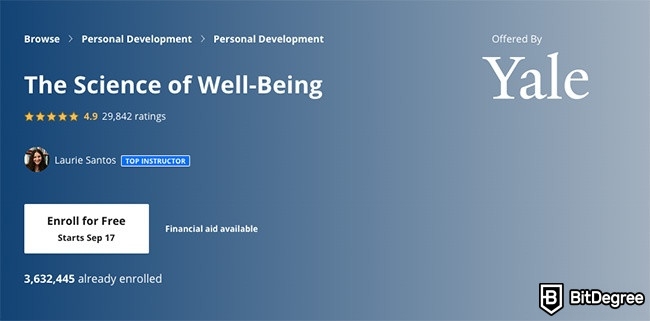
Following these tips should help you find it easier to concentrate and study. And don't forget – this isn't an exhaustive list. Find what works best for you and adapt it to your daily routine.
Prospects and Opportunities with Distance Learning
The move to remote learning has provided us with some unexpected opportunities. With more time on our hands than ever before, we saw an influx of new hobbies, interests, and trends (remember all those arts and crafts projects?).
However, it wasn’t all about raising the perfect loaf of bread or creating a small botanical garden in your bedroom. There have been more online open courses available than ever – and no better time to try them out and learn something new.

While distance education has opened many doors, some extracurricular activities had to be left behind. The opportunities to make your CV stand out seemed to have dwindled. It’s been a scary time for new professionals to kickstart their careers.
Here’s where online courses came into play. MOOCs offer an opportunity to learn a new skill on your own. It’s like a digital extracurricular. Perhaps even one not provided by your school or university!
Distance learning courses are really good for students. A mix of formal education and online courses can help deepen their knowledge and develop new skills. For instance, beginner-level coding courses can be applied in IT classes, while the Intro to Psychology course offered by Udacity is a great headstart on your degree.
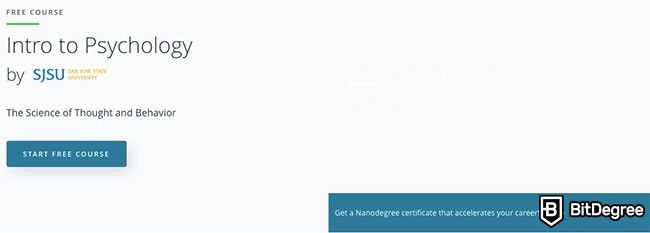
University students can probably benefit the most from MOOCs. A lot of the programs are led by not just industry experts but academics. Many of the most popular online courses are offered by the best institutions in the world, like Harvard, Columbia, and other universities you might find in the Ivy League.
Here’s a fun fact for you: you can use your MOOC certificate for your university credit. Yes, you read that right. With the edX MicroMasters program, you can speed boost your degree with the skills you already have.
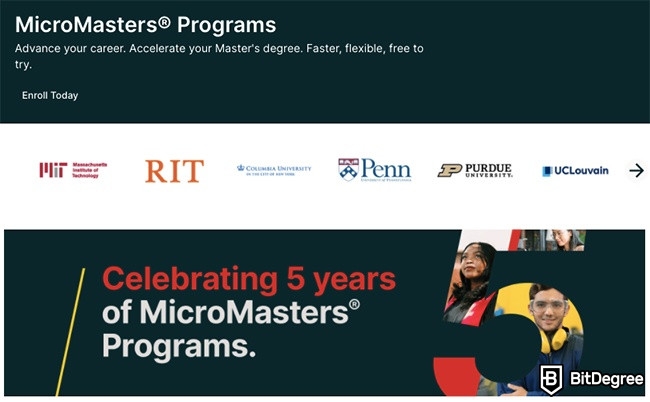
Basically, taking a MOOC can directly impact your academic career.
Online courses also pay off. Some paid courses may appear like a lot for your pockets, but there’s no need to worry. Partnerships between learning platforms and universities mean that you can get a scholarship that pays for part or all of the course costs.
Have I mentioned that you receive a certificate when you finish a course? Just like a university diploma, it’s all official proof of the skills you’ve worked hard on and earned. You can add it to your LinkedIn profile, mention it in your cover letter or print it out and hang it on your wall. Extra skills will always make you stand out.

Of course, this doesn’t just apply to schools and universities. With the uncertainty of the world, mass layoffs, and plenty of time to think, lots of people started reconsidering their life course and polishing their cover letters. The question of changing careers has turned from an “if” to a “when”.
As for that "when"? There's no time like the present.
Longer specialization courses are especially helpful to take the first step of your brand new career path. These are made up of several asynchronous distance learning courses. Unlike some individual courses, they can take a couple of months to complete. And that’s still faster than getting a whole new degree!
Choosing the Right Online Course
If you end up with some spare time from your regular distance learning, you might want to learn an extra skill or two. You’ll often hear people talk about “embellishing your CV”, and some extra credit can be a big help here.
Perhaps you want to learn about UX/UI, but it’s not part of your IT curriculum. Or you’ve always been interested in graphic design, but the nearest art school is three towns away. Here’s where online courses come in.
There are multiple platforms on the web that offer thousands of courses taught by internationally renowned experts. It’s like a digital candy store – except many of the sweets are free of charge. It can be overwhelming at first, but don’t worry. There are steps you can take to find what you need.

Here are some of the tips to choose the right distance learning courses for you:
- Plan ahead.
Do you want to complete a single course? Or would you rather have a whole new specialization? Online courses on Udacity can take anywhere from a handful of hours to several weeks to complete. However, these courses are self-paced. You might even finish a month-long course in ten days. So, plan ahead and set yourself a clear goal. - Shop around.
There are so many platforms to choose from. Some, like Datacamp, are more focused, while others like Skillshare offer more casual classes in their catalogs. So, see what course structures, lengths, or any other factors appeal to you the most. Still spoiled for choice? We’ve combined this helpful list of the best online learning platforms for you to check out. - Dig deeper.
With thousands of courses, you will probably come across some hidden gems. You can always choose one of the most popular, of course, but take a look further down the catalog. Perhaps you’ll find the perfect niche for you – like this course on Ancient Egyptian Art offered by edX. That being said… - Mind the ratings.
The top courses are on the front page for a reason. They offer the best learning materials taught by experts. You can trust the information to be reliable, and their quality is unlikely to disappoint. Take a look at the reviews – you’ll find out exactly how good these courses are in practice. - Don’t overcommit.
Let’s say you’ve signed up for the Udacity Intro to Programming class. And you’ve found another cool course. Oh, another one! And one more. Suddenly, two weeks have gone by, you’ve barely made progress, and you can feel the burnout setting in. It’s a real motivation-killer. Of course, it’d be easy to say not to limit yourself. But be mindful that it takes effort to study efficiently. You can always go back to the courses that interest you later. - Go exploring.
So, you’ve decided it’s time for you to learn Python. You’ve found the Python Bootcamp course on Udemy, you have your certificate. Now what? Well, why not try out something completely different? Career development is a good goal, but you can learn something completely for fun. And yes, it’ll end up being a nice bonus on your CV, too.


Did you know?
Have you ever wondered which online learning platforms are the best for your career?
Conclusions
So, today we’ve answered the question of what is distance learning, learned how synchronous and asynchronous learning differ, and saw how learning online compares to sitting in a classroom. We saw the different types of online learning and how it can work not just as general education but as extracurriculars as well.
The pandemic has reshaped our understanding of learning. It’s not all about working in person – distance education can be just as successful, if not more. The key is learning to adapt and sticking to effective learning techniques. Perhaps you’ll find that you prefer studying remotely. Or even that self-study works better for you than synchronous learning.
In the end, in order to succeed, you need to study effectively. Take another look at the suggested distance learning tips and see what could work for you. Hopefully, they’ll help you become a better student.
And if you’re interested in some self-study, why not choose one of the distance learning courses mentioned in this article? From digital marketing to artificial intelligence, your choices are endless. Still unsure where to start? Take another look at our list of the best-ranked online learning platforms. Even if you’re not a student, it’s never too late to learn something new.
Scientific References
1. R. Vuorikari, A. Velicu, S. Chaudron et al. ‘How families handled emergency remote schooling during the Covid-19 lockdown in spring 2020’
2. Shivangi Dhawan 'Online Learning: A Panacea in the Time of COVID-19 Crisis'

